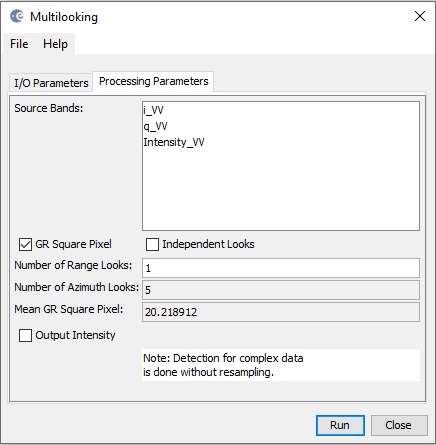Multilook Operator
Generally, a SAR original image appears speckled with inherent
speckle noise. To reduce this inherent speckled appearance, several
images are incoherently combined as if they corresponded to
different looks of the same scene. This processing is generally
known as multilook processing. As a result the multilooked
image improves the image interpretability. Additionally,
multilook processing can be used to produce an application product
with nominal image pixel size.
Multilook Method
There are two ways to implement the multilook
processing:
- The multilooked images can be produced by space-domain
averaging of a single look image, either with or without specific
2D kernels by convolution.
- The multilook images can be produced by frequency-domain method
using the sub-spectral band width.
This operator implements the space-domain
multilook method by averaging a single look image with a small
sliding window.
Selecting Range and Azimuth Looks
In selecting the number of range looks and the
number of azimuth looks, user has two options:
- GR square pixel: the user specifies the number of range looks
while the number of azimuth looks is computed based on the ground
range spacing and the azimuth spacing. The window size is then
determined by the number of range looks and the number of azimuth
looks. As a result, image with approximately square pixel spacing
on the ground is produced.
- Independent looks: the number of looks in range and azimuth can
be selected independently. The window size is then determined by
the number of range looks and the number of azimuth looks.
Multilook Complex Product
- When the input product is complex, if you want to multilook the
intensity image, you should select the intensity band by
highlighting it in the Source Bands window. If no bands are
selected, then the I and Q bands are selected by default and
multilooked. The virtual intensity band generated from the
multilooked I and Q bands is NOT the multilooked intensity
band.
- When the input is a complex interferogram product and you are
interested in multilooking the phase, you should NOT select the
phase band. Instead, you should select the I and Q bands. The
desired phase band is generated from the multilooked I and Q bands.
Otherwise, artefacts, such as the bell-shaped histogram, will be
introduced in the multilooked phase band.
Parameters Used
The following parameters are used by the
operator:
- Source Band: All bands (real or virtual) of the source product.
User can select one or more bands for producing multilooked images.
If no bands are selected, then by default all bands are
selected.
- GR Square Pixel: If selected, the number of azimuth looks is
computed based on the user selected number of range looks, and
range and azimuth spacings are approximately the same in the
multilooked image.
- Independent Looks: If selected, the number of range looks
and the number of azimuth looks are selected independently by the
user.
- Number of Range Looks: The number of range looks.
- Number of Azimuth Looks: The number of azimuth looks.
- Mean GR Square Pixel: The average of the range and azimuth
pixel spacings in the multilooked image. It is computed based on
the number of range looks, the number of azimuth looks and the
source image pixel spacings, and is available only when 'GR Square
Pixel' is selected.
- Output Intensity: This checkbox is for complex product only. If
not checked, any user selected bands (I, Q, intensity or phase) are
multilooked and output individually. If checked, user can only
select I/Q or intensity band and the output is multilooked
intensity band.
-

Reference: Small D., Schubert A., Guide to ASAR
Geocoding, RSL-ASAR-GC-AD, Issue 1.0, March 2008


